
views
Kayak Entry
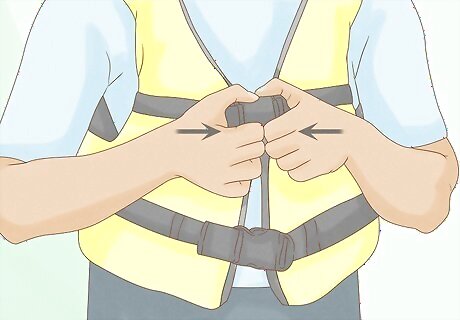
Put on a lifejacket and secure it before kayaking to stay safe. You should never go kayaking without a lifejacket. Either buy a lifejacket or get one from a rental company. Slide the lifejacket on over your head and clip the straps together on your chest. Pull the loose ends on the straps to tighten the lifejacket and fit it tight on your chest.Tip: As a rookie kayak enthusiast, go out kayaking with at least one other partner or an instructor. This way, you’ll have help nearby if you fall out or run into trouble. You should also wear a hard-shell helmet if you’re going white-water kayaking or kayaking in a river. It’s not a good idea to do this your first time out, though.
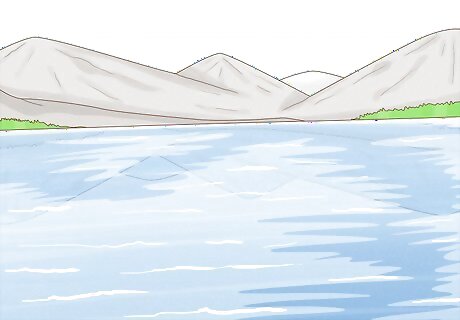
Find a calm, rock-free area to enter the water from the shore. If you’re taking the kayak out from a beach or shoreline, look for a smooth area where there’s a gradual slope into the water. Avoid areas where you see rocks or debris sticking out of the water. If you’re getting into a kayak from a dock, you don’t need to worry about finding a calm spot to take the boat out.
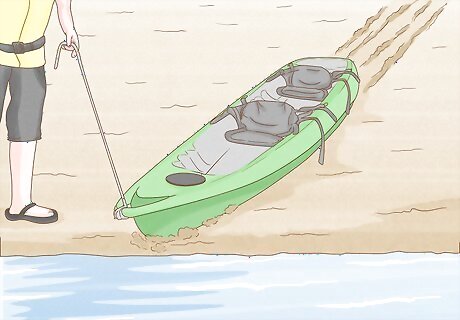
Drag the kayak on to the shore by holding the strap in the front. To move the kayak, look at the front of the boat for a fabric strap. Grab this strap and drag the kayak slowly to take it closer to the water. If you’re with someone else, feel free to carry the kayak together to keep it off of the ground by holding it from each end. You don’t need to do this if the kayak is tied to a dock.
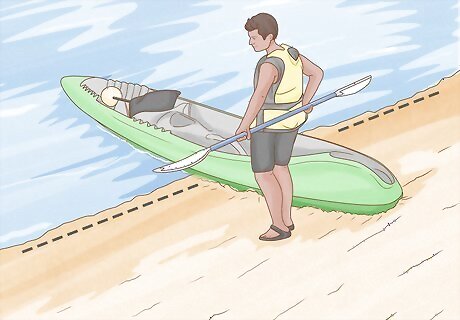
Let the kayak down so the cockpit rests over the edge of the water. Drag the kayak directly to the edge of the water. Hold the paddle behind you while you drag the kayak with your free hand. Continue dragging the kayak and let it down so that the cockpit is resting on the spot where the water meets the shore. If the paddle is in front of you and you drop it in the water, it may float away.
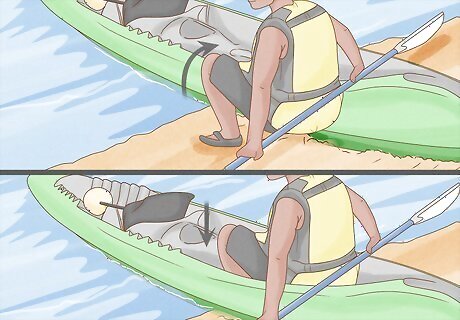
Scoot your way into the cockpit and extend your feet out. Set the paddle flat against the back of the cockpit and sit on the edge of the kayak. Then, slowly scoot your butt into the cockpit and bring your feet in one at a time. Slide back in the seat so you’re sitting up straight and extend your feet out in front of you to sit in the kayak. If you’re getting in from a dock, use the edge of the dock to balance yourself. Set your feet inside the cockpit and stay low to balance your weight. Balance the paddle on the edge of the dock while you get in and sit in the seat. If there are footrests inside of your kayak, put your feet on them. Most people do not wear shoes when they’re kayaking. If you do want to wear shoes, throw on some water shoes.
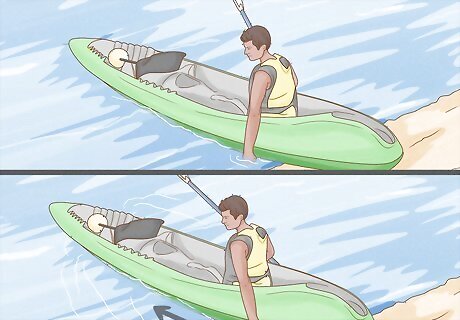
Push yourself out into the water using your paddle and body weight. When you’re ready to embark on the water, grab the paddle and raise it vertically on your side. Dig the blade into the shore and scoot your weight forward repeatedly to push off into the water. If you’re with any other people, ask someone to just push you into the water. This is a lot easier than scooting yourself in. If you’re embarking from a dock, either wait for the tie rope to be untied by the dockmaster or untie it from the boat yourself and leave it tied to the cleat on the dock.
Paddle Placement
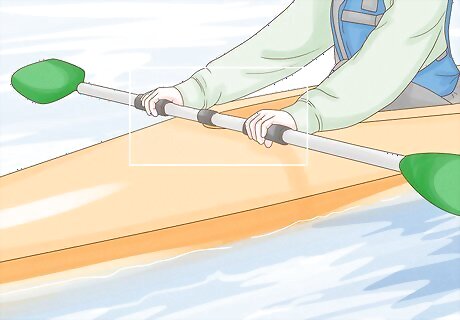
Hold the paddle horizontally with both hands. In your kayak, hold the paddle horizontally in front of you. Hold your paddle with both hands in case you drop it. Grip the bar with a fist by wrapping your thumbs under your 4 fingers. If you aren’t comfortable while you’re holding the paddle, you’re doing it wrong. The paddle should feel comfortable in your palms. You don’t need to squeeze the handle hard to hold it. However, don’t relax your grip to the point that your hands slide around the bar.
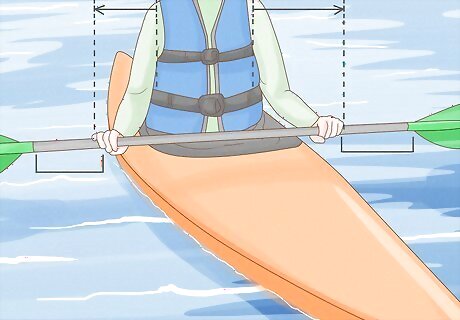
Hold the paddle so your hands are stretched out a little past your shoulders. Grip the paddle in the middle so there’s an equal amount of space in between each hand and the blades on each side. Make minor adjustments with your grip to stay comfortable.
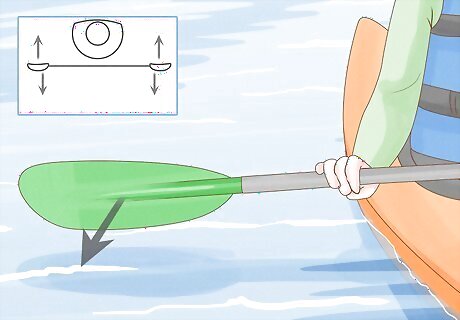
Turn the paddle in your hand so the smooth and concave side faces you. The fins on the end of the kayak paddle are called blades. These blades are not identical on both sides, so inspect them to see which side is smooth and concave. Turn the paddle in your had so that the smooth and concave sides face you. When you paddle, orient the blades so that they’re perpendicular to the surface of the water.
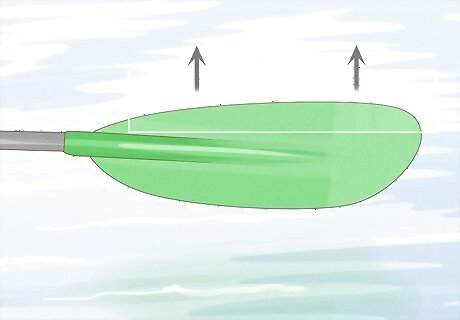
Orient the blades so that the flat horizontal edge is on top. Inspect the long sides of each blade. The straightest horizontal edge always goes on top. If there is an angle at the end of each blade, the angle always points up and away from you. Flip the paddle around so the left and right side swap if your blades are upside down.Warning: Always check your blades before you paddle out. If your blades aren’t angled correctly, you may totally throw your balance off and fall in the water.
Paddling Technique

Stay upright and maintain a firm grip when paddling the kayak. Sit up straight in your kayak and keep your core engaged. You can lean forward a little if you have to, but you may lose control of the kayak as your center of gravity shifts if you start moving your torso back or to a side. Keep your feet on the footrests while you’re paddling. If you don’t have footrests, keep your feet stretched out in front of you. You can bend your knees a little bit if it’s more comfortable for you.
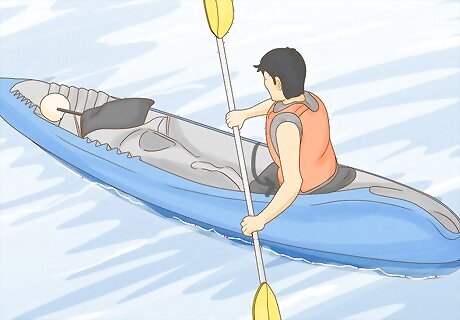
Raise the paddle up and twist your torso. Lift your paddle up a little but keep your elbows under your shoulders. To propel yourself forward, twist your chest a little in whichever direction it feels comfortable to start. If you turn to the left, shift your paddle a little to the left and vice versa. Tip: When you paddle on the right side, you’ll turn slightly to the left. When you paddle on the left side, you’ll turn slightly to the right. By alternating between paddling on the right and the left, you’ll push yourself forward. Most of your power comes from your chest, not your arms. This is why coiling your upper body back is important when you start paddling.
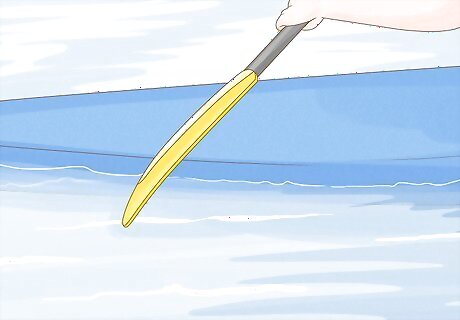
Angle the paddle while bringing the raised blade forward. As you start the stroke, tilt the blade you pulled back down 15- to 25-degrees. Push the raised blade forward while lowering it towards the water. Do this in a kind of semi-circle so that the raised blade goes up and lowers down almost perpendicular to the water. If it helps, imagine that you’re turning two gears with each arm moving in opposite directions. The arm moving forward turns at the same time as your other arm lowers back behind you.

Dig the blade into the water and untwist your torso to push forward. Push the front blade down into the water so that it’s just under the surface of the water. Then, pull the blade back towards you. At the same time, pull your back shoulder forward to untwist your torso. Push the blade you have raised out of the water forward while doing this. If you’re paddling correctly, you should eventually feel your core, chest, and shoulders getting sore at roughly the same time.
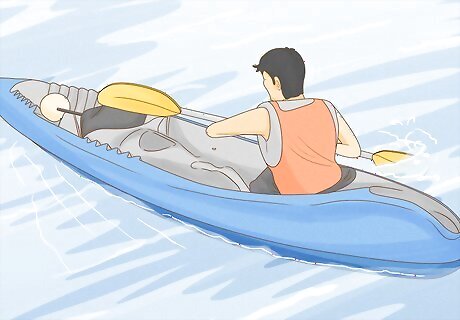
Repeat this action on the opposite side to propel yourself forward. As you drag the paddle underwater, curl your torso towards it so your shoulder is always pointing at the blade that’s underwater. Then, start lifting the blade out of the water while lowering the blade on the opposite side. Push the raised blade into the water and pull it back while uncoiling yourself to keep paddling forward.
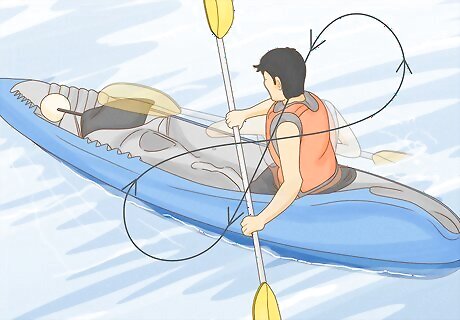
Find a rhythm as you paddle to continue going forward. As you paddle, you will feel how the kayak shifts slightly with each individual stroke. Find a pattern where that shifting is even on both sides to keep your kayak moving straight. Use an equal amount of strength with each stroke to move consistently and smoothly. Tip: If you fall out of the kayak at any point, stay calm. First, flip the kayak back over. Then, reach over the kayak grab the opposite side of the cockpit. Start kicking and get as close as you can to the horizontal surface of the water. Pull yourself up while kicking hard and reorient yourself in the seat.
Turning and Slowing Down
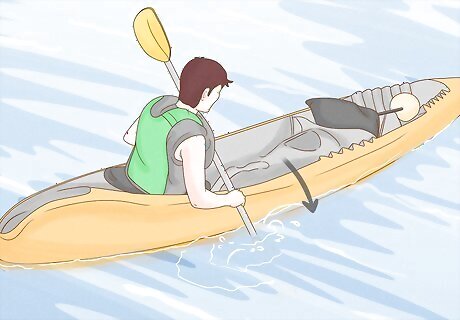
Use sweep strokes to pivot the angle of the kayak and turn. To turn left, extend the right side of your paddle out in front of you and lower it into the water. Twist your torso to the left and drag the paddle backwards in a semi-circular motion while uncoiling your upper body. Repeat this stroke if you need to keep turning and reverse the direction to go to the right.Tip: You can repeatedly paddle like you normally do on one side of the kayak to turn, but this is kind of difficult to do correctly and it’s not particularly energy efficient. It’s much easier to use one or two sweeping strokes to change the angle of the boat and continue paddling forward. Your chest turns in the opposite direction that you’re moving the paddle to compensate for the shift in your center of gravity. Maintain your center of balance while doing this. It can be kind of tempting to lean towards the paddle while you do this, but you may fall into the water if you lean too far.
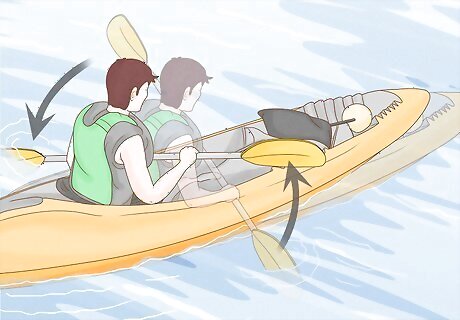
Paddle in the opposite direction to brake or slow down. If you want to slow down or go backwards, paddle the same way you go forward, but in reverse. Stick your right blade underwater, slide it forward, then lower your left blade underwater as you raise the right blade out. Slide the left blade forward and repeat this process to either slow yourself down while travelling forward or paddle in reverse. To slow down while turning at the same time, just stick one of your blades into the water and hold it still. To turn right, put your right blade underwater. To turn left, stick your left blade underwater.

Hold the paddle vertically to use draw strokes to move sideways. If you’re trying to line up with the dock when you’re coming back or if you’re kayaking with other people and you’re close to bumping into someone, hold your paddle vertically with both hands. Then, stick one blade underwater with the flat side facing away from you. Slowly push the blade away from you to push yourself sideways without changing the angle of the boat. If it’s more comfortable, point the blade towards your kayak and pull it towards you on the opposite side to move the same direction.
Getting Out
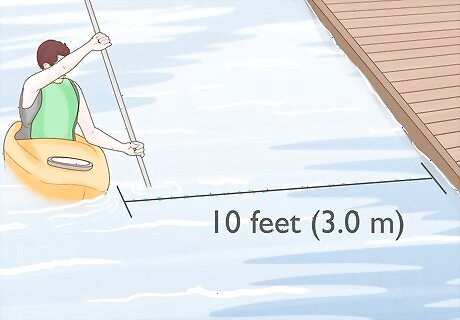
Paddle towards a dock and use draw strokes to get parallel. If you’re returning to a dock, paddle straight towards the side and slow down gradually as you get close. When you’re within 10 feet (3.0 m) of the side of the dock, brake entirely and use draw strokes to line up with the side of the dock.
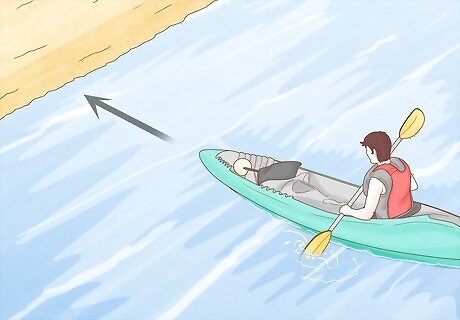
Use forward strokes to paddle on the shore for a beach landing. If you’re landing on the beach or shore, paddle forward. Find a calm part of the shore with an even, flat surface to land and angle the kayak towards that. Continue paddling forward until the front of your kayak slides forward on to the ground.
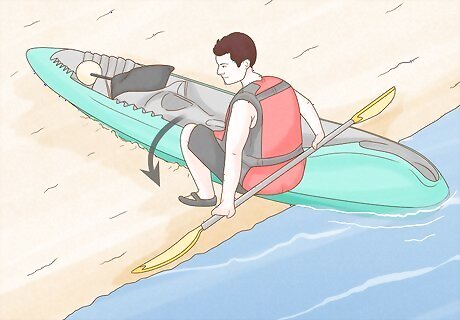
Step out of the water or use the dock to lift yourself out. For a shore landing, once your kayak slides on to the ground, use the sides of the cockpit to push yourself up. Step into the water and hold the paddle in one hand. Grab the strap on the front of the boat with your other hand and pull the kayak on the shore. For a dock landing, hold the side of the dock and carefully lift yourself up on to it.Tip: It can be kind of hard to balance yourself when you stand up on the kayak for a dock landing. Just go slowly and keep your weight low to avoid falling.
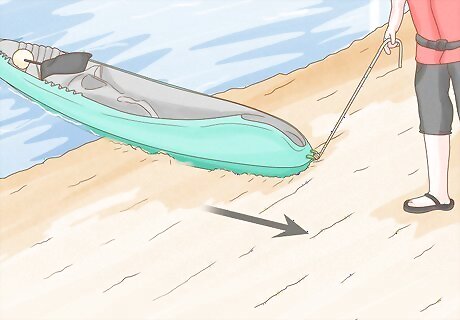
Secure the kayak with a tie line or by pulling it out with the strap. For a beach landing, grab the front of the kayak by the strap and slide it all the way on to the shore so that the water isn’t within 10 feet (3.0 m) of the boat. Otherwise, the kayak may get pulled out into the water. For a dock landing, use the rope on the dock to tie the boat to the cleat. If you’re taking the kayak out of the dock, grab the strap on the front of the kayak and pull it up on to the dock.


















Comments
0 comment